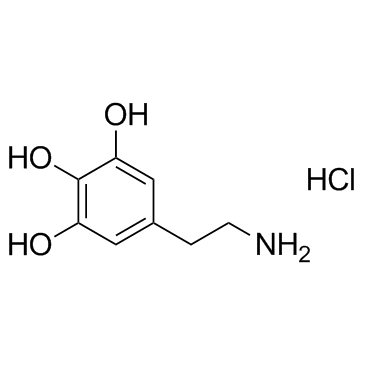Differential dopaminergic regulation of proenkephalin and prodynorphin mRNAs in the basal ganglia of rats.
S Reimer, D J Sirinathsinghji, K E Nikolorakis, V Höllt
Index: Brain Res. Mol. Brain Res. 12(1-3) , 259-66, (1992)
Full Text: HTML
Abstract
Proenkephalin and prodynorphin mRNA levels in the caudate-putamen and in the nucleus accumbens of rats were measured by in situ hybridization 2, 4 and 8 weeks following unilateral lesion of the medial forebrain bundle by 6-hydroxydopamine (6-OHDA). After 2 weeks a 60% increase of the levels of proenkephalin mRNA in the ipsilateral caudate-putamen was observed which declined to 20% above control after 8 weeks. A smaller increase in the levels of proenkephalin mRNA of about 20% was observed in the nucleus accumbens after 2 weeks and no significant alteration could be observed 4 and 8 weeks after lesioning. The levels of prodynorphin mRNA in the ipsilateral caudate-putamen decreased 20% below control and returned to control levels 4 and 8 weeks post-lesion. In contrast, in the nucleus accumbens a persistent ipsilateral decrease of prodynorphin (20-30%) was found 2, 4 and 8 weeks post-lesion. These findings indicate, that lesions of the mesostriatal dopamine (DA) system differentially influences opioidergic gene expression in distinct areas of the caudate-putamen. The lesions cause an increase in proenkephalin mRNA levels which was higher in the caudate-putamen than in the nucleus accumbens and tend to be reversible. Conversely, the lesion caused a persistent decrease in the levels of prodynorphin mRNA in the nucleus accumbens and a small and transient decrease in the caudate-putamen.
Related Compounds
| Structure | Name/CAS No. | Molecular Formula | Articles |
|---|---|---|---|
 |
5-Hydroxydopamine hydrochloride
CAS:5720-26-3 |
C8H12ClNO3 |
|
A microdialysis study on striatal dopamine, 5-HT and metabol...
1993-10-25 [Neuroreport 5(1) , 53-6, (1993)] |
|
Biochemical and behavioral recovery in a rodent model of Par...
1992-02-01 [Exp. Neurol. 115(2) , 193-9, (1992)] |
|
Uptake of 5-hydroxydopamine into non-sympathetic nerves of g...
1993-03-01 [J. Neurocytol. 22(3) , 164-75, (1993)] |
|
Protective effects of green tea polyphenols and their major ...
2002-01-01 [Redox Rep. 7(3) , 171-7, (2002)] |
|
Electron microscopic evidence for neurotoxicity in the basal...
1995-02-01 [Neurochem. Int. 26(2) , 195-202, (1995)] |